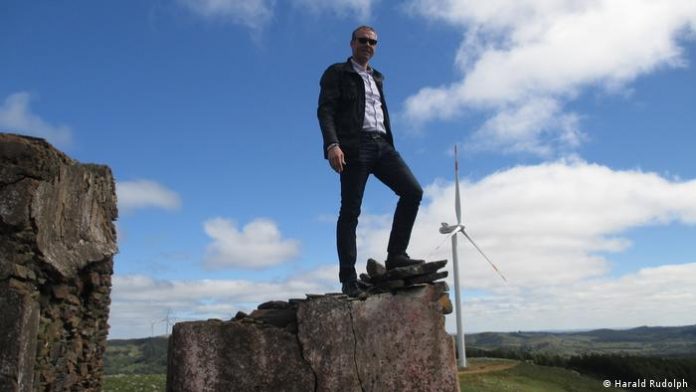For Harald Rudolph, there is not just a little more than 11,000 kilometers between Hohfleck in Baden-Württemberg and Minas and Pastorale in Uruguay. For the managing director of the wind farm developer Sowitec, the spots in southern Germany and South America are worlds apart.
On the one hand, a wind farm that should be up and running in 2024 – a whopping eleven years after the state government gave the green light. At the other end of the world 30 turbines planned by Sowitec, which were built in a fast-track process.
Rudolph says: “In Uruguay, the authorities are all pulling in the same direction. You sit down together, look for solutions and in most cases you find a consensus. And in this country we’re not looking for solutions, we’re looking for problems.”
Harald Rudolph is probably exactly the right man to explain why Germany is not getting into trouble when it comes to converting to renewable energies. The hurdles in the never-ending story of the Hohfleck wind farm, 100 kilometers south of Stuttgart, are as follows: monument protection, the rotors disturbing the picture-postcard idyll of Lichtenstein Castle. Species protection, the strictly protected bird of prey red kite nests nearby, dormice have to be relocated. And, above all, approval procedures, which are almost endlessly drawn out.
“In the case of the red kite, we told the authorities that we would switch off the systems from morning to evening if the bird could fly into the danger area. So you’ve solved the red kite problem, and then citizens’ groups will come around the corner with a bat. Then you solve it this problem and then the authorities say: ‘But the report is too old now.’ Of course it’s too old when you haven’t decided anything for years.”
German energy transition in slow motion
Stories like these are standard in Germany, and by 2030 80 percent of electricity consumption is to be covered by renewable sources. Above all, wind power must increase massively in the next few years. “Do your job, federal states!” was the ardent appeal from Economics and Climate Protection Minister Robert Habeck these days at the Wind Energy trade fair in Hamburg.
No wonder, in Bavaria just eight wind turbines were connected to the grid in 2021, in Baden-Württemberg only 28. In the whole of Germany only 484 onshore wind turbines were installed last year. If Germany continues at this pace, the ambitious goals will remain a pipe dream.
Uruguay: Model country and pioneer in renewable energies
Physicist Ramón Méndez is the mastermind behind the wind power miracle in the sparsely populated country. In 2008, Méndez drafted the 25-year plan for Uruguay’s energy policy, for which many initially ridiculed him, but to which all parties committed themselves. Today, almost all electricity in Uruguay comes from renewable sources at 98 percent, with wind power leading the way at 40 percent, followed by hydropower, biomass and solar energy.
A few years ago, the renowned magazine Fortuna listed Méndez as one of the 50 outstanding global leaders for showing that it is possible to create a coal-free economy. Méndez sums up the result of this success story as follows:
“Today we are completely independent of gas, oil and coal prices, the war in Ukraine has no impact on us, we already know the electricity prices for the next ten years. In return, these transformations have given us investments of 13 percent of the gross domestic product and created 50,000 jobs. Uruguay has changed from an importer of electricity at horrendous prices to an exporter, which flushes into our coffers hundreds of millions of euros a year.”
The energy transition still has its price
But the fairy tale of Uruguay’s energy transition also has its downsides. Not only is the cost of the investment passed on to the consumer, the state also sees energy prices as a bubbling source of income for other policy areas.

“Politicians like ex-president José Mujica have played a large part in Uruguay’s change” – Ramón Méndez
The population therefore pays significantly more for clean electricity than in Chile, Brazil or Argentina, and poorer families spend up to 15 percent of their monthly income on electricity. For Méndez, however, this is also a result of the increased quality of life in the South American country:
“We have reduced poverty here from 38 percent to under 10 percent in the last 15 years, extreme poverty has disappeared, which means that people are also consuming more. That means many of them used to have no air conditioning, today they do. And that’s what Uruguayans see on their electricity bills.”
The population saw change as an opportunity
Ramón Méndez now heads the Ivy Foundation in Montevideo, which advises politicians, business leaders and citizens’ groups throughout Latin America on how to live more sustainably. He was just invited to speak at a conference in Buenos Aires to explain the secret of Uruguay’s energy transition.
More cattle than people live in the small country of 3.5 million people, but such an ambitious project is still possible in any country in the world – even in Germany, Méndez is certain.
“Uruguay doesn’t have the sun of Chile or the wind of Patagonia. I would say our starting conditions are okay, but not very good either. But we all have the vision here that it’s good to be part of modernity. People see along We are very proud of the wind turbines and do not see them as a disfigurement of the landscape. The sight of a turbine is the smallest of all possible damages. And the question above all is: ‘What would be the alternative?'”













